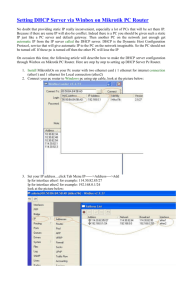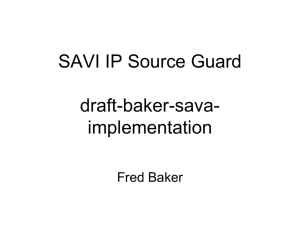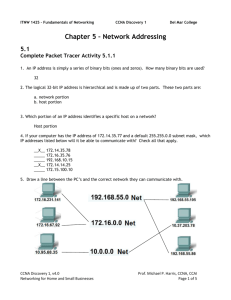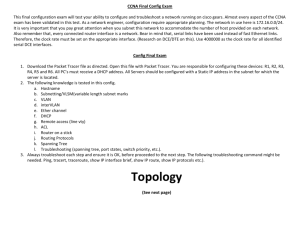5.1.4 How IP Addresses and Subnet Masks Interact
advertisement
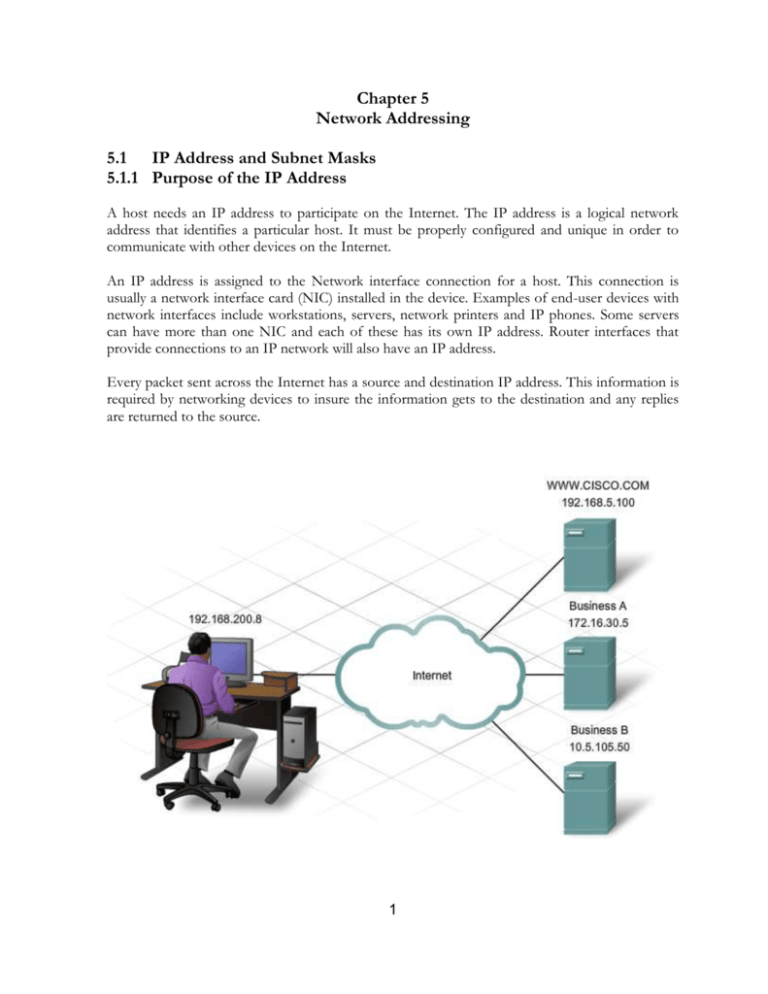
Chapter 5 Network Addressing 5.1 IP Address and Subnet Masks 5.1.1 Purpose of the IP Address A host needs an IP address to participate on the Internet. The IP address is a logical network address that identifies a particular host. It must be properly configured and unique in order to communicate with other devices on the Internet. An IP address is assigned to the Network interface connection for a host. This connection is usually a network interface card (NIC) installed in the device. Examples of end-user devices with network interfaces include workstations, servers, network printers and IP phones. Some servers can have more than one NIC and each of these has its own IP address. Router interfaces that provide connections to an IP network will also have an IP address. Every packet sent across the Internet has a source and destination IP address. This information is required by networking devices to insure the information gets to the destination and any replies are returned to the source. 1 Packet Tracer Activity Use Packet Tracer to ping different websites. Click the Packet Tracer icon to begin. 5.1.2 IP Address Structure An IP address is simply a series of 32 binary bits (ones and zeros). It is very difficult for humans to read a binary IP address. For this reason, the 32 bits are grouped into four 8-bit bytes called octets. An IP address in this format is hard for humans to read, write and remember. To make the IP address easier to understand, each octet is presented as its decimal value, separated by a decimal point or period. This is referred to as dotted-decimal notation. When a host is configured with an IP address, it is entered as a dotted decimal number such as 192.168.1.5. Imagine if you had to enter the 32-bit binary equivalent of this11000000101010000000000100000101. If just one bit was mistyped, the address would be different and the host may not be able to communicate on the network. The 32-bit IP address is defined with IP version 4 (IPv4) and is currently the most common form of IP address on the Internet. There are over 4 billion possible IP addresses using a 32-bit addressing scheme. 2 When a host receives an IP address, it looks at all 32 bits as they are received by the NIC. Humans, on the other hand, need to convert those 32 bits into their four octet decimal equivalent. Each octet is made up of 8 bits and each bit has a value. The four groups of 8 bits have the same set of values. The rightmost bit in an octet has a value of 1 and the values of the remaining bits, from right to left, are 2, 4, 8, 16, 32, 64 and 128. Determine the value of the octet by adding the values of positions wherever there is a binary 1 present. If there is a 0 in a position, do not add the value. If all 8 bits are 0s. 00000000 the value of the octet is 0. If all 8 bits are 1s, 11111111 the value of the octet is 255 (128+64+32+16+8+4+2+1). If the 8 bits are mixed, such as the example 00100111, the value of the octet is 39 (32+4+2+1). So the value of each of the four octets can range from 0 to a maximum of 255. 3 5.1.3 Parts of an IP Address The logical 32-bit IP address is hierarchical and is made up of two parts. The first part identifies the network and the second part identifies a host on that network. Both parts are required in an IP address. As an example, if a host has IP address 192.168.18.57 the first three octets, (192.168.18), identify the network portion of the address, and the last octet, (57) identifies the host. This is known as hierarchical addressing because the network portion indicates the network on which each unique host address is located. Routers only need to know how to reach each network, rather than needing to know the location of each individual host. Another example of a hierarchical network is the telephone system. With a telephone number, the country code, area code and exchange represent the network address and the remaining digits represent a local phone number. 4 Activity Drag the PCs to the correct network address based on their IP Address Drag each host to the correct network 5.1.4 How IP Addresses and Subnet Masks Interact There are two parts to every IP address. How do hosts know which portion is the network and which is the host? This is the job of the subnet mask. When an IP host is configured, a subnet mask is assigned along with an IP address. Like the IP address, the subnet mask is 32 bits long. The subnet mask signifies which part of the IP address is network and which part is host. The subnet mask is compared to the IP address from left to right, bit for bit. The 1s in the subnet mask represent the network portion; the 0s represent the host portion. In the example shown, the first three octets are network, and the last octet represents the host. When a host sends a packet, it compares its subnet mask to its own IP address and the destination IP address. If the network bits match, both the source and destination host are on the same network and the packet can be delivered locally. If they do not match, the sending host forwards the packet to the local router interface to be sent on to the other network. 5 The subnet masks we see most often with home and small business networking are: 255.0.0.0 (8bits), 255.255.0.0 (16 bits) and 255.255.255.0 (24 bits). A subnet mask of 255.255.255.0 (decimal) or 11111111.11111111.1111111.00000000 (binary) uses 24 bits to identify the network number which leaves 8 bits to number the hosts on that network. To calculate the number of hosts that can be on that network, take the number 2 to the power of the number of host bits (2 ^ 8 = 256). From this number, we must subtract 2 (256-2). The reason we subtract 2 is because all 1s within the host portion of an IP address is a broadcast address for that network and cannot be assigned to a specific host. All 0s within the host portion indicates the network ID and again, cannot be assigned to a specific host. Powers of 2 can be calculated easily with the calculator that comes with any Windows operating system. Another way to determine the number of hosts available is to add up the values of the available host bits (128+64+32+16+8+4+2+1 = 255). From this number, subtract 1 (255-1 = 254), because the host bits cannot be all 1s. It is not necessary to subtract 2 because the value of all 0s is 0 and is not included in the addition. With a 16-bit mask, there are 16 bits (two octets) for host addresses and a host address could have all 1s (255) in one of the octets. This might appear to be a broadcast but as long as the other octet is not all 1s, it is a valid host address. Remember that the host looks at all host bits together, not at octet values. 6 Lab Activity Convert between binary and decimal numbers. Work with powers of 2 to calculate the number of hosts available with x number of bits in the host portion of the address. Click the lab icon to begin. 7 5.2 Types of IP Addresses 5.2.1 IP Address Classes and Default Subnet Masks The IP address and subnet mask work together to determine which portion of the IP address represents the network address and which portion represents the host address. IP addresses are grouped into 5 classes. Classes A, B and C are commercial addresses and are assigned to hosts. Class D is reserved for multicast use and Class E is for experimental use. Class C addresses have three octets for the network portion and one for the hosts. The default subnet mask is 24 bits (255.255.255.0). Class C addresses are usually assigned to small networks. Class B addresses have two octets to represent the network portion and two for the hosts. The default subnet mask is 16 bits (255.255.0.0). These addresses are typically used for medium-sized networks. Class A addresses have only one octet to represent the network portion and three to represent the hosts. The default subnet mask is 8 bits (255.0.0.0). These addresses are typically assigned to large organizations. The class of an address can be determined by the value of the first octet. For instance, if the first octet of an IP address has a value in the range 192-223, it is classified as a Class C address. As an example, 200.14.193.67 is a Class C address. 8 5.2.2 Public and Private IP Addresses 9 All hosts that connect directly to the Internet require a unique public IP address. Because of the finite number of 32-bit addresses available, there is a risk of running out of IP addresses. One solution to this problem was to reserve some private addresses for use exclusively inside an organization. This allows hosts within an organization to communicate with one another without the need of a unique public IP address. RFC 1918 is a standard that reserves several ranges of addresses within each of the classes A, B and C. As shown in the table, these private address ranges consist of a single Class A network, 16 Class B networks and 256 Class C networks. This gives a network administrator considerable flexibility in assigning internal addresses. A very large network can use the Class A private network, which allows for over 16 million private addresses. On medium size networks, a Class B private network could be used, which provides over 65,000 addresses. Home and small business networks typically use a single class C private address, which allows up to 254 hosts. The Class A network, the 16 Class B networks, or the 256 Class C networks can be used within any size organization. Typically many organizations use the Class A private network. Private addresses can be used internally by hosts in an organization as long as the hosts do not connect directly to the Internet. Therefore, the same set of private addresses can be used by multiple organizations. Private addresses are not routed on the Internet and will be quickly blocked by an ISP router. The use of private addresses can provide a measure of security since they are only visible on the local network, and outsiders cannot gain direct access to the private IP addresses. 10 There are also private addresses that can be used for the diagnostic testing of devices. This type of private address is known as a loopback address. The class A, 127.0.0.0 network, is reserved for loopback addresses. 11 5.2.3 Unicast, Broadcast and Multicast Addresses In addition to address classes, we also categorize IP addresses as unicast, broadcast, or multicast. Hosts can use IP addresses to communicate one-to-one (unicast), one-to-many (multicast) or oneto-all (broadcast). Unicast A unicast address is the most common type on an IP network. A packet with a unicast destination address is intended for a specific host. An example is a host with IP address 192.168.1.5 (source) requesting a web page from a server at IP address 192.168.1.200 (destination). For a unicast packet to be sent and received, a destination IP address must be in the IP packet header. A corresponding destination MAC address must also be present in the Ethernet frame header. The IP address and MAC address combine to deliver data to one specific destination host. 12 Broadcast With a broadcast, the packet contains a destination IP address with all ones (1s) in the host portion. This means that all hosts on that local network (broadcast domain) will receive and look at the packet. Many network protocols, such as ARP and DHCP use broadcasts. A Class C network 192.168.1.0 with a default subnet mask of 255.255.255.0 has a broadcast address of 192.168.1.255. The host portion is decimal 255 or binary 11111111 (all 1s). A Class B network of 172.16.0.0, with a default mask of 255.255.0.0, has a broadcast of 172.16.255.255. A Class A network of 10.0.0.0, with a default mask of 255.0.0.0, has a broadcast of 10.255.255.255.. A broadcast IP address for a network needs a corresponding broadcast MAC address in the Ethernet frame. On Ethernet networks, the broadcast MAC address is 48 ones displayed as Hexadecimal FF-FF-FF-FF-FF-FF. 13 Multicast Multicast addresses allow a source device to send a packet to a group of devices. Devices that belong to a multicast group are assigned a multicast group IP address. The range of multicast addresses is from 224.0.0.0 to 239.255.255.255. Since multicast addresses represent a group of addresses (sometimes called a host group), they can only be used as the destination of a packet. The source will always have a unicast address. Examples of where multicast addresses would be used are in remote gaming, where many players are connected remotely but playing the same game. Another example would be distance learning through video conferencing, where many students are connected to the same class. As with a unicast or broadcast address, multicast IP addresses need a corresponding multicast MAC address to actually deliver frames on a local network. The multicast MAC address is a special value that begins with 01-00-5E in hexadecimal. The value ends by converting the lower 23 bits of the IP multicast group address into the remaining 6 hexadecimal characters of the Ethernet address. An example, as shown in the graphic, is hexadecimal 01-00-5E-0F-64-C5. Each hexadecimal character is 4 binary bits. 14 15 5.3 How IP Addresses are Obtained 5.3.1 Static and Dynamic Address Assignment IP addresses can be assigned either statically or dynamically. Static With a static assignment, the network administrator must manually configure the network information for a host. At a minimum, this includes the host IP address, subnet mask and default gateway. Static addresses have some advantages. For instance, they are useful for printers, servers and other networking devices that need to be accessible to clients on the network. If hosts normally access a server at a particular IP address, it would not be good if that address changed. Static assignment of addressing information can provide increased control of network resources, but it can be time consuming to enter the information on each host. When entering IP addresses statically, the host only performs basic error checks on the IP address. Therefore, errors are more likely to occur. When using static IP addressing, it is important to maintain an accurate list of which IP addresses are assigned to which devices. Additionally, these are permanent addresses and are not normally reused. 16 Dynamic On local networks it is often the case that the user population changes frequently. New users arrive with laptops and need a connection. Others have new workstations that need to be connected. Rather than have the network administrator assign IP addresses for each workstation, it is easier to have IP addresses assigned automatically. This is done using a protocol known as Dynamic Host Configuration Protocol (DHCP). DHCP provides a mechanism for the automatic assignment of addressing information such as IP address, subnet mask, default gateway, and other configuration information. DHCP is generally the preferred method of assigning IP addresses to hosts on large networks since it reduces the burden on network support staff and virtually eliminates entry errors. Another benefit of DHCP is that an address is not permanently assigned to a host but is only leased for a period of time. If the host is powered down or taken off the network, the address is returned to the pool for reuse. This is especially helpful with mobile users that come and go on a network. 17 5.3.2 DHCP Servers If you enter a wireless hotspot at an airport or coffee shop, DHCP makes it possible for you to access the Internet. As you enter the area, your laptop DHCP client contacts the local DHCP server via a wireless connection. The DHCP server assigns an IP address to your laptop. Various types of devices can be DHCP servers as long as they are running DHCP service software. With most medium to large networks, the DHCP server is usually a local dedicated PCbased server. With home networks the DHCP server is usually located at the ISP and a host on the home network receives its IP configuration directly from the ISP. Many home networks and small businesses use an integrated router to connect to the ISP modem. In this case, the integrated router is both a DHCP client and a server. The integrated router acts as a client to receive its IP configuration from the ISP and then acts a DHCP server for internal hosts on the local network. In addition to PC-based servers and integrated routers, other types of networking devices such as dedicated routers can provide DHCP services to clients, although this is not as common. 18 5.3.3 Configuring DHCP When a host is first configured as a DHCP client, it does not have an IP address, subnet mask or default gateway. It obtains this information from a DHCP server, either on the local network or one located at the ISP. The DHCP server is configured with a range, or pool, of IP addresses that can be assigned to DHCP clients. A client that needs an IP address will send a DHCP Discover message which is a broadcast with a destination IP address of 255.255.255.255 (32 ones) and a destination MAC address of FF-FFFF-FF-FF-FF (48 ones). All hosts on the network will receive this broadcast DHCP frame, but only a DHCP server will reply. The server will respond with a DHCP Offer, suggesting an IP address for the client. The host then sends a DHCP Request to that server asking to use the suggested IP address. The server responds with a DHCP Acknowledgment. For most home and small business networks, a multi-function device provides DHCP services to the local network clients. To configure a Linksys wireless router, access its graphical web interface by opening the browser and entering the in the Address area the router default IP address: 192.168.1.1. Navigate to the screen that shows the DHCP configuration. The IP address of 192.168.1.1 and subnet mask of 255.255.255.0 are the defaults for the internal router interface. This is the default gateway for all hosts on the local network and also the internal DHCP server IP address. Most Linksys wireless routers and other home integrated routers have DHCP Server enabled by default. On the DHCP configuration screen a default DHCP range is available or you can specify a starting address for the DHCP range (do not use 192.168.1.1) and the number of addresses to be assigned. The lease time can also be modified (default is 24 hours). The DHCP configuration 19 feature on most ISRs gives information about connected hosts and IP addresses, their associated MAC address, and lease times. The DHCP Client Table also shows the client name and whether it is connected via the Ethernet LAN or wireless (Interface). 5.4 Address Management 5.4.1 Network Boundaries and Address Space The router provides a gateway through which hosts on one network can communicate with hosts on different networks. Each interface on a router is connected to a separate network. The IP address assigned to the interface identifies which local network is connected directly to it. Every host on a network must use the router as a gateway to other networks. Therefore, each host must know the IP address of the router interface connected to the network where the host is attached. This address is known as the default gateway address. It can be either statically configured on the host, or received dynamically by DHCP. When an integrated router is configured to be a DHCP server for the local network, it automatically sends the correct interface IP address to the hosts as the default gateway address. In 20 this manner, all hosts on the network can use that IP address to forward messages to hosts located at the ISP and get access to hosts on the Internet. Integrated routers are usually set to be DHCP servers by default. The IP address of that local router interface becomes the default gateway address for the host configuration. The default gateway is provided, either statically or by DHCP. When an integrated router is configured as a DHCP server, it provides its own internal IP address as the default gateway to DHCP clients. It also provides them with their respective IP address and subnet mask. 5.4.2 Address Assignment The integrated router acts as a DHCP server for all local hosts attached to it, either by Ethernet cable or wirelessly. These local hosts are referred to as being located on an internal, or inside, network. Most DHCP servers are configured to assign private addresses to the hosts on the internal network, rather than Internet routable public addresses. This ensures that, by default, the internal network is not directly accessible from the Internet. The default IP address configured on the local integrated router interface is usually a private Class C address. Internal hosts must be assigned addresses within the same network as the integrated router, either statically configured, or through DHCP. When configured as a DHCP server, the 21 integrated router provides addresses in this range. It also provides the subnet mask information and its own interface IP address as the default gateway. Many ISPs also use DHCP servers to provide IP addresses to the Internet side of the integrated router installed at their customer sites. The network assigned to the Internet side of the integrated router is referred to as the external, or outside, network. When an integrated router is connected to the ISP, it acts like a DHCP client to receive the correct external network IP address for the Internet interface. ISPs usually provide an Internetroutable address, which enables hosts connected to the integrated router to have access to the Internet. The integrated router serves as the boundary between the local internal network and the external Internet. There are several ways hosts can be connected to an ISP and the Internet. Whether or not an individual host is assigned a public or private address depends on how it is connected. Direct Connection Some customers have just a single computer with a direct connection from the ISP through a modem. In this case, the public address from the ISP DHCP server is assigned to the single host. Connection Through an Integrated Router 22 When there is more than one host that needs access to the Internet, the ISP modem can be attached directly to an integrated router instead of directly to a single computer. This enables the creation of a home or small business network. The integrated router receives the public address from the ISP. Internal hosts receive private addresses from the integrated router. Connection Through a Gateway Device Gateway devices combine an integrated router and a modem in one unit, and connect directly to the ISP service. As with integrated routers, the gateway device receives a public address from the ISP and internal PCs will receive private addresses from the gateway device. 5.4.3 Network Address Translation The integrated router receives a public address from the ISP, which allows it to send and receive packets on the Internet. It, in turn, provides private addresses to local network clients. Since private addresses are not allowed on the Internet, a process is needed for translating private addresses into unique public addresses to allow local clients to communicate on the Internet. The process used to convert private addresses to Internet-routable addresses is called Network Address Translation (NAT). With NAT, a private (local) source IP address is translated to a public (global) address. The process is reversed for incoming packets. The integrated router is able to translate many internal IP addresses to the same public address, by using NAT. 23 Only packets destined for other networks need to be translated. These packets must pass through the gateway, where the integrated router replaces the source host's private IP address with its own public IP address. Although each host on the internal network has a unique private IP address assigned to it, the hosts must share the single Internet routable addressed assigned to the integrated router. 5.5 Chapter Summary 5.5.1 Summary 24 25 26 27
